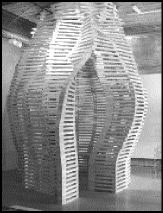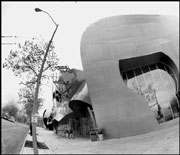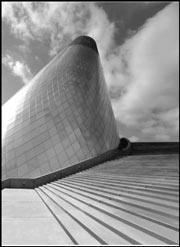BLURRED
CoCA 1420 11th, 728-1980 2-8 p.m. Tues.-Thurs.; noon-5 p.m. Fri.-Sat. ends Fri., Sept. 13
Despite Seattle’s image as a cutting-edge town, we’re surrounded by architectural conservatism. But “blurred”—a quickly assembled show at the Center on Contemporary Art’s new Capitol Hill quarters, produced on a shoestring—may signify the emergence of an energetic and committed new generation of local designers.
There wasn’t room for the crowd of 500 on opening night (Aug. 3), just as there wasn’t enough space for the 14 highly varied works on display. This sense of concentrated energy, of ignoring limits, and of attempting more than was realistically possible all fit in with the show’s underlying intentions.
According to curators Kai-Uwe Bergmann and John N. Bohn, “blurred” “seeks to explore the breadth and depth of architectural possibility, expanding the traditional definition of architecture in the Northwest.” A tall order, especially for an undertaking that was self-financed by the artists (most of whom are architecturally educated) and came together in just a few weeks. I’m not convinced that the show meets its grand goals, but I’m quite certain that this shortfall is unimportant. What counts more is the determination to act, even if there’s no budget and the setting is constrained.
Bergmann and Bohn winnowed 34 proposals down to 14, with an eye to maximizing variety of approach. There are works that “focus on materials and space” and that “explore construction techniques;” virtual environments; filmed, photographed, or drawn interpretations of buildings and spaces; and conceptual and process pieces. The pieces vary widely in their success, but each work cultivates territory that the others do not, and several are particularly satisfying.
AlphaZett CITY, Michael Barrette’s spectacular digital drawings of cityscapes and ruins, deserves to be blown up to a monumental scale. Mark Johnson’s CORNER: CoCA is a vigorously lyrical curving lath construction colonizing a corner of the gallery, with one tendril escaping through a missing windowpane as though seeking the sunlight. INVERSION 1 by lead pencil studio is an intricate welded wire assembly whose delicate floating form magically obscures the borders between drawing and sculpture and abstraction and representation. r-b-f architecture’s RE: SHINGLE is a space enclosure that can be observed but not entered, created by laying up 7,000 recycled cedar slivers, held together without fasteners by gravity alone, and simultaneously achieving solidity and transparency.
As far as I can tell, nothing like this group exhibit has transpired here in a long time, if ever. Will the future look back on “blurred” and acknowledge it as a seminal event? Or will it be just an isolated bump in the otherwise smooth road of architectural thinking in Seattle? Bohn and Bergmann are both relocating in a month, one to teach in New England and one to travel and live in Europe. It would be wonderful if our nascent architectural avant-garde could find ways to continue emerging, strengthening, and expanding itself and eventually making its mark.








